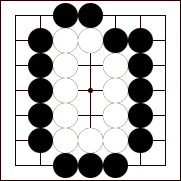|
For a group of stones to be captured, all the intersections touching the group must be filled. The group must not only be surrounded on the outside, but empty spaces inside the group adjacent to the stones must be filled also. A single empty space inside a group is called an eye. Indeed, by the end of the game, for a group to remain alive it must contain at least two separate spaces. One of the key themes in Go battles is creating eye space for your own groups and trying to prevent the opponent from making eyes.
In Diagram 1 the White group has one eye, and is completely surrounded on the outside. Thus the White group has only one liberty. Black
can kill the White group by filling the one eye, as in Diagram 2.
If the White group had any liberties remaining on the outside, this
move could not be played, as placing a stone where it can be captured
(suicide) is illegal. Diagram 3 shows the position after the White stones have been captured. Black has gained 14 points (7 spaces surrounded and 7 prisoners). Diagram 4 shows the steps of the capturing sequence. |
 |
 |
 |
 |
 |
 |
 |
 |
 |
 |
 |
 |
 |
 |
 |
 |
 |
 |
 |
 |
|
Early
in the game, when the board is mostly empty, stones that are threatened
with capture can try to save themselves by extending out and increasing
their liberties. However, as the game goes on and more and more spaces
get filled, groups start to surround each other. But not all groups
that are surrounded can be captured. A group that surrounds at least
two separate eyes can never be captured, because both eyes cannot be
filled at the same time.
In Diagram5, although White is completely surrounded on the outside, White has two eyes and is safe. In
Diagram 6, what is the correct move if it is White's turn to
play? What is the move if it is Black's turn? Diagram 7: If it is White's turn to play, making the second eye ensures safety. Diagram 8: If it is Black's turn to play, Black would push in at the same point, taking away White's second eye and placing the four stones at the bottom in atari. If White connects his stones, Black captures the entire group by playing in the one remaining eye.
Diagram 9 shows the result after the capture. Black has gained 24 points (12 points for the surrounded spaces and 12 for the captured stones). |
|
|
 |
|
Diagram
10: In
this position, what is the correct move if it is White's turn to move?
What if it is Black's turn? Diagram 11: If it is White's turn, White should of course play at 1, creating the familiar safe position with two eyes. Diagram
12: If Black plays at 1, White can no longer create
two eyes and the White group will die. The following diagrams demonstrate
the capturing sequence. Diagram 13: White can do nothing - if White plays inside, only one liberty remains, and Black captures immediately. So Black will play again, putting the group in atari. Diagram
14: White may capture the two stones. However .
. . Diagram 15: Now White has only two connected liberties and . . . Diagram
16: Black can return and once more place the group in
atari. White can again capture, but . . . Diagram 17: Now White is left with only one eye. Diagram 18: Black now captures the entire White group by filling this last remaining liberty. |
|
[Capturing] [Contents - Learning Go] [The Ko]
|